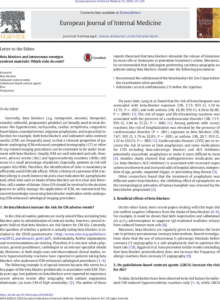Rachel looks in the mirror and notices a mark on her cheek. Immediately her breath becomes shallow, her heart races, her chest tightens, and she feels nauseated. She checks the spot more closely, and sees that it’s just a speck of dirt. She washes it off and tells herself firmly that she is fine – it wasn’t the beginning of skin cancer, it was nothing. It’s gone. She is okay.
Although she keeps telling herself she is okay, hours later, Rachel still doesn’t feel okay. What if seeing that spot was a “sign”? What is she is about to develop skin cancer? What if she already has skin cancer and she just hasn’t seen it yet? Should she go see her doctor? Recurring thoughts of cancer hover in the back of her mind for the rest of the day. Weeks later she notices she is still spending an increased amount of time inspecting her skin for unusual marks or blemishes.
Like an estimated 13-16.5% of adults, Rachel has an anxiety disorder. Types of anxiety disorders include generalized anxiety disorder, panic disorder, agoraphobia, social phobia, obsessive-compulsive disorder, and post traumatic stress disorder.
At times the symptoms of anxiety can become so debilitating that those affected will not leave their home or attend social functions – and their lives may become consumed by the effort to avoid people, places or situations which are likely to trigger feelings of anxiety.
Traditional treatment for anxiety disorder has involved medication to help to lessen the symptoms of anxiety, and behavioral therapy to assist with coping and challenging irrational thoughts. Treatment is generally expected to be long term.
Zensight Process offers new hope to those with anxiety. In many cases, a practitioner who is very skilled with both Zensight and in working with those with anxiety, can help someone to experience dramatic improvement – and in some cases a complete elimination of symptoms – in just a few sessions.
In most situations, many individuals will be able to use Zensight on their own – without ever consulting a practitioner at all – to considerably improve and sometimes even eliminate their symptoms altogether. Those who do choose to work with a therapist or practitioner to help support and accelerate their healing will also benefit from doing Zensight self-healing in between sessions, in order to obtain the best results.
How to Use Zensight Process
Zensight Process involves working with the subconscious mind in a way that is similar to hypnosis – and yet no hypnosis is actually used. Instead, we begin by creating a “healing symbol”. This symbol can be a word, picture, or colour. Some people choose to use a symbol such as “ocean”. They then can focus on the word “ocean” when that feels right, and at other times may actually visualize the ocean.
When this healing symbol is used or focused upon with intent, it allows the fears, concerns, and “blocks” that someone is experiencing to gently heal and transform.
The healing symbol is then used together with healing statements and visualization, to soften, dissolve and release the concerns that are being experienced.
In a situation of anxiety, the individual is instructed to stop and notice any visual image that comes to mind when she or he thinks about one of their specific concerns – and then focus upon this image while connecting with the healing symbol that was chosen.
This use of visualization helps to greatly accelerate healing because it does not rely upon the limits of our conscious mind and awareness. The visual image that comes up may be an actual representation of a specific fear or issue that is being experienced, or it may be something that is metaphorical in nature. I have had people tell me that they suddenly see a picture of themselves with their leg caught in a trap, or that they see a large grey object that they can’t identify or make sense of. The different images that come up are highly variable and are not always understood by the person. The beauty of it is that they don’t need to be understood. The image is simply focused upon while connecting with the healing symbol, and is allowed to transform.
What generally happens is that the image spontaneously transforms in a way that feels healing. The individual watches as the trap that was holding the leg simply dissolves and disappears. They see themselves then being able to move about freely and with a sense of contentment and peace. The big unexplained grey object morphs into a big egg which opens up and releases light and a feeling of peace that the person senses themselves absorbing as she or he watches.
If the picture doesn’t change, if no picture is seen, or in order to resolve any remaining upset, the individual uses healing statements. After each statement, the person takes a deep breath and lets it go, and focuses upon the healing symbol. Upsets are then healed and transformed, as positive feelings grow and strengthen.
Examples of healing statements are:
- I heal all of the fears that any parts of me have, that I can’t get free of this problem
- I heal any and all feelings that any parts of me have, that I am trapped.
- I let all of the parts of me know, deeply and completely, that I am safe.
- All of the different parts of me now experience a growing sense of peace and comfort.
- My entire body is relaxing now.
Sound simple? It is – extremely simple, and yet powerfully and deeply effective. Best of all, the effects are lasting – providing that energetic imbalances are addressed and healed, results will in most cases be permanent.
Energy Balancing
Zensight can be used for much more than simply targeting specific symptoms. In the case of anxiety – especially experiences of pervasive fear and anxiety – it is best to begin by targeting energetic imbalances that are most likely being experienced.
Someone who experiences frequent and/or pervasive feelings of fear has an imbalance in his or her triple warmer meridian. The energy meridians have been widely recognized in Eastern medicine as impacting upon our emotional, physical, and mental concerns. Acupuncture is only one of many modalities which focus upon bringing healing to the energy meridians.
The triple warmer meridian is the meridian in the body which governs the fight/flight/freeze response. Sometimes – often in response to an original event or series of events in which the individual felt intense fear or terror – the triple warmer meridian becomes overenergized. In the case of anxiety, the emphasis will be upon the “flight/freeze” response, and the individual will quickly respond with fear to many situations which may to others appear innocuous.
Trying to talk someone out of their fear often has little effect. Rachel rationally knows that the mark on her face was simply dirt and was no more an indicator of cancer than is a stain on her jeans. However, in spite of this awareness, and in spite of her logical mind which tells her she is safe and is overreacting, Rachel can not let the fear go.
The problem that Rachel is experiencing is not in her mind so much as in her body and in her energy system. Often patterns of triple warmer overenergization begin in childhood, in response to repeated experiences of terror. Sometimes this may be due to experiences of abuse that were either experienced or witnessed, and sometimes it may be connected with less obviously traumatic experiences that were nevertheless fear-producing for the particular child involved.
Rachel knows that she is safe – but her body and energy system need to know it too. In a sense, they need to be reprogrammed. With Zensight, this “reprogramming” can occur gently and easily during a rapid yet extremely relaxing process.
Other energetic imbalances may also be involved. Homolateral energy (where the energy runs straight up and down the body rather than crossing over it) may also be involved. Once any energetic imbalances that are involved are addressed, many symptoms of anxiety will lessen immediately. The work then becomes focused on targeting the concerns more directly.
Bringing Healing to the “Whole” Person
The emphasis which Zensight Process places upon using both visualization and verbal “healing statements” ensures that both hemispheres of the brain are involved during the healing process. This assists people in linking logic with emotion. After using Zensight, not only does Rachel logically understand that the spot on her face was not a sign of impending doom – she emotionally “gets it” as well.
Zensight also addresses the experience of parts of self. All of us have parts of self. In many situations where healing is not experienced even when highly effective modalities are being used, the issue is that the person on some level – in some small part of them – may believe that it’s not safe to heal the concerns. Rachel may be afraid to completely heal her anxiety because some small part of her may fear that if she stops worrying about and expecting to develop cancer, that she will pay less attention and will miss warning signs and thus be unsafe. Zensight allows the individual to access and bring healing to – through the use of visualization and targeted healing statements – to even those parts of us that are afraid to heal, or believe it is not in our best interests to do so.
By ensuring that the individual is treated at as a whole – physically, emotionally, mentally, and energetically – Zensight enables even concerns that are usually considered to be difficult to impossible to resolve, to be as gently and quickly healed as possible.











